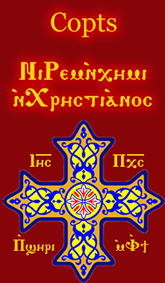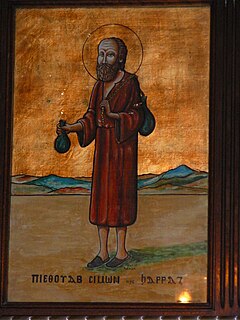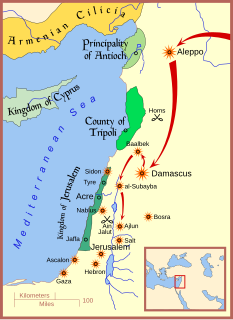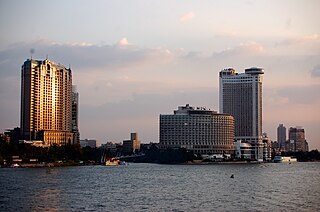
The Coptic Orthodox Church of Alexandria is an Oriental Orthodox Christian church based in Egypt, Africa and the Middle East. The head of the Church and the See of Alexandria is the Patriarch of Alexandria on the Holy See of Saint Mark, who also carries the title of Coptic Pope. The See of Alexandria is titular, and today the Coptic Pope presides from Saint Mark's Coptic Orthodox Cathedral in the Abbassia District in Cairo. The church follows the Alexandrian Rite for its liturgy, prayer and devotional patrimony. With 18–22 million members worldwide, whereof about 15 to 18 million are in Egypt, it is the country's largest Christian church.

The Patriarch of Alexandria is the archbishop of Alexandria, Egypt. Historically, this office has included the designation "pope".

This article uses dates and years written in the Coptic calendar, using the A.M. calendar era, in addition to the Gregorian calendar, using the A.D. calendar era.
Dionysius I Telmaharoyo, also known as Dionysius of Tel Mahre, was the Patriarch of Antioch, and head of the Syriac Orthodox Church from 818 until his death in 845.
The British Orthodox Church, formerly known as the Orthodox Church of the British Isles, is a small independent Oriental Orthodox church defining its mission to the people of the British Isles. It has not been in communion with any of the Oriental Orthodox churches since a 2015 decision to return to an independent condition.
Pope Christodolos of Alexandria, 66th Pope of Alexandria and Patriarch of the See of St. Mark.

The Pope of the Coptic Orthodox Church of Alexandria is the leader of the Coptic Orthodox Church of Alexandria, a faith with ancient Christian roots in Egypt. The current holder of this position is Pope Tawadros II, who was selected as the 118th pope on November 18, 2012.

The Holy Synod of the Coptic Orthodox Church of Alexandria is the highest Orthodox authority in the Coptic Orthodox Church of Alexandria. It formulates the rules and regulations regarding matters of the church's organisation and faith.

The Syrian Monastery is a Coptic Orthodox monastery located in Wadi El Natrun, Beheira Governorate, Egypt. It is located about 500 meters northwest of the Monastery of Saint Pishoy. Ecclesiastically, the monastery is dedicated to the Virgin Mary and carries her name; and in scholarly references from the nineteenth century, it is generally called the covenant/convent/monastery of St. Mary Deipara. However, it is nowadays better known as the Syrian Monastery because it was mainly used by Syriac monks.

Saint Virgin Mary's Coptic Orthodox Church also known as The Hanging Church is one of the oldest churches in Egypt and the history of a church on this site dates to the third century. It belongs to the Coptic Orthodox Church of Alexandria.

Saints Sergius and Bacchus Church, also known as Abu Serga, in Coptic Cairo is one of the oldest Coptic churches in Egypt, dating back to the 4th century.

The Church of the Holy Virgin in Babylon El-Darag is a Coptic Orthodox church in Coptic Cairo built in the 11th century AD.

Coptic history is part of history of Egypt that begins with the introduction of Christianity in Egypt in the 1st century AD during the Roman period, and covers the history of the Copts to the present day. Many of the historic items related to Coptic Christianity are on display in many museums around the world and a large number is in the Coptic Museum in Coptic Cairo.
Ignatius Noah of Lebanon, also known as Nuh the Lebanese, was the Patriarch of Antioch, and head of the Syriac Orthodox Church from 1493 until his death in 1509.
Oriental Orthodoxy is the communion of Eastern Christian Churches that recognize only three ecumenical councils — the First Council of Nicaea, the First Council of Constantinople and the Council of Ephesus. They reject the dogmatic definitions of the Council of Chalcedon. Hence, these Churches are also called Old Oriental Churches or Non-Chalcedonian Churches.

Oriental Orthodoxy is the fourth largest communion of Christian churches, with about 76 million members worldwide. As one of the oldest religious institutions in the world, it has played a prominent role in the history and culture of Armenia, Egypt, Eritrea, Ethiopia, Sudan and parts of the Middle East and India. An Eastern Christian communion of autocephalous churches, its bishops are equal by virtue of episcopal ordination, and its doctrines can be summarised in that the communion recognizes the validity of only the first three ecumenical councils.
Athanasius I Gammolo was the Patriarch of Antioch, and head of the Syriac Orthodox Church of Antioch from 595 until his death in 631. Athanasius was also the author of The Life of Severus of Antioch, a biography of the first Syriac Orthodox Patriarch of Antioch.
John IV was the Patriarch of Antioch, and head of the Syriac Orthodox Church from 846 until his death in 873.















